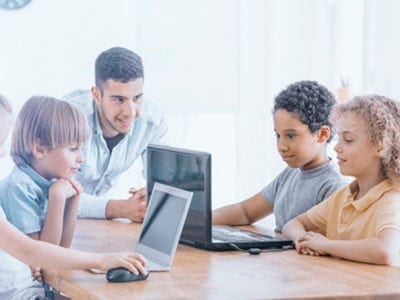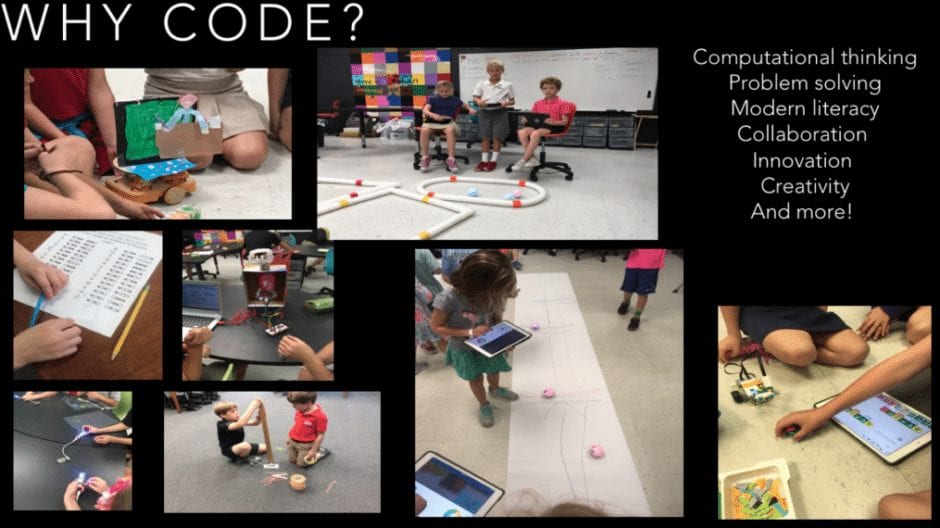Keep Your Class Engaged Beyond the Hour of Code
This year during the annual Computer Science Education Week, educators and students around the world participated in the Hour of Code, an event designed to demystify and engage educators and students in coding. What are some ways to get started with coding, for an Hour of Code or afterwards? Kelly Knight, STEAM Coordinator at Riverside Presbyterian Day School, Jacksonville, FL, presented ideas and tips in “Get Ready for Hour of Code.”
Set your classroom up for success. Instead of a typical classroom, Kelly designs her room to be more like a makerspace where kids work in groups on different problem-solving activities, like coding. Through coding, kids increase their computational and innovative thinking, expand their creativity and collaboration, and learn how to think outside the box and have more confidence in themselves. “(Coding) is the new literacy of today and children pick it up very easily, and at least in my experience seem to love really it,” said Kelly. Educators can access free resources and games at hourofcode.com.
If your school does not have a program or is not already on board with coding, your administration must see that introducing coding is worthwhile. Seeing results from other schools’ programs is one way to do this. You should show passion about bringing coding into the school by being willing to be the one who teaches it, Kelly noted. It’s also important to be flexible in the beginning as you seek support to start your program from parents or the administration. Incorporating different STEM or STEAM activities into your exercises will help get all students engaged and on board with coding. Kids will see that they can merge their other skills and talents with these activities.
Get started with coding using free apps such as Scratch and ScratchJr, which students can use to tell stories and create their own games. Unplugged coding activities are also an option. Kelly incorporates a “bubbles and binary” activity into a science lesson. The students spell the first letter of their name in binary code using beads onto the handle of a bubble wand, which they’ve engineered themselves with pipe cleaners. She also has students play a partner game where one person is a programmer and the other is a robot. The programmer must draw a program for their robot using different symbols, like move forward, jump, or squat. With technology or unplugged activities, students can participate in not just an Hour of Code, but continue throughout the year.
This broadcast was hosted by edWeb.net and sponsored by littleBits Education.
This article was modified and published by eSchool News.
About the Presenter
Kelly Knight has worked for two years as the STEAM coordinator at Riverside Presbyterian Day School located in Jacksonville, FL. She facilitates a dedicated classroom makerspace where students, grades K-6, visit once a week to enhance their learning with STEAM-themed projects and challenges. Kelly provides students with access to a variety of tools and multiple forms of technology so that they have the opportunity to develop diverse skill sets. Students learn basic design and engineering principles, as well as circuitry, coding, robotics and most recently, 3D printing and design. Coding education has been enhanced by learning through technology like littleBits, as well as Sphero, KIBO, MaKey MaKey, and LEGO WeDo. Students have also used programs like Scratch and its app counterpart ScratchJr to develop coding skills.
Join the Community
STEM Learning: Full STEAM Ahead is a free professional learning community that provides educators, curriculum leaders, and industry members with a place to collaborate on bringing more science, technology, engineering, and mathematics into the classroom.
littleBits makes technology kits that are fun, easy-to-use, and infinitely creative. The kits are composed of electronic building blocks that are color-coded, magnetic, and make complex technology simple and fun. Together they’re interchangeable in millions of different ways to empower kids to invent anything – from a sibling alarm, to a wireless robot, to a digital instrument.





Comments are closed.